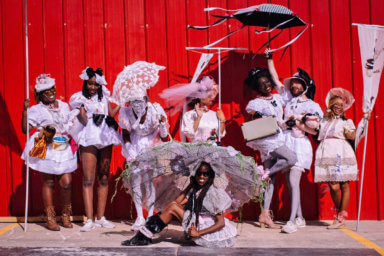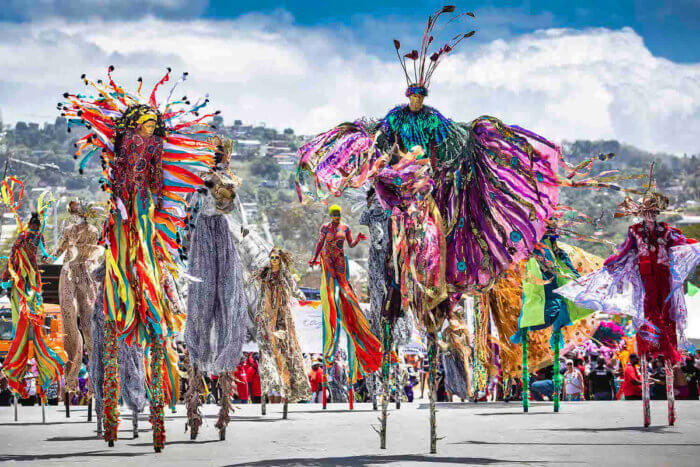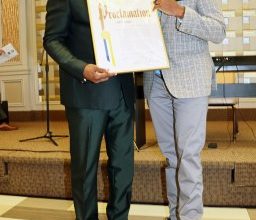‘The Art of Rebellion’: The Baby Doll Masquerade in T&T Carnival

The Smithsonian Center for Folklife & Cultural Heritage has featured “The Art of Rebellion,” a series of articles that it says reveals “the essence of Trinidad and Tobago’s Carnival, one of the most influential street festivals in the world,” through an exploration of important traditional carnival characters.
Beginning just after Christmas, the center said the carnival season is marked by weekly fetes (parties), competitions, and, in every neighborhood, “the unmistakable sound of the steelpan.
“Carnival practitioners spend months preparing for the culmination of the festivities on the two days immediately preceding the Catholic observance of Ash Wednesday,” the center said. “With its long history, carnival combines costuming elements of the European colonizers with religious and traditional aspects of African, Indian and indigenous cultures.
“While some characters and rituals originated during the slave trade, the end of slavery in 1838 ushered in the official two-day celebration,” it added. “In many ways, it served, then and now, as a form of healing, rebirth and transformation for Trinidadians and Tobagonians.”
The Smithsonian Center for Folklife & Cultural Heritage said carnival in Trinidad and Tobago inspires offshoots in major cities around the world.
“But still, thousands of visitors flock to the (twin) island-state to experience events firsthand,” it said. “This has made carnival a significant economic driver for local artists.
“However, traditional knowledge related to historical characters and rituals too often die with practitioners, robbing younger generations of their cultural inheritance,” the center added. “Although traditional characters remain commonplace in Trinidad’s Carnival, their origins and importance have faded from the memories of most locals.
“In their place, a mass-produced carnival has emerged, one that tramples the efforts of our ancestors to be seen, heard and understood using the social and political commentary that accompanies most traditional characters,” it continued. “As their cries fade, so too does our ability to truly understand our history and ourselves. Today, there are traditional masqueraders who choose to maintain the original portrayals, and others who subvert them in order to give them bold new meanings.”
The Smithsonian Center for Folklife & Cultural Heritage said mas, the shortened form of masquerade, is divided into two main categories: pretty mas and ole (old) mas.
It said pretty mas costumes, the more glamorous version of Trinidad and Tobago’s Carnival, feature “stylized body suits or bikinis with matching arm and leg pieces along with a wire-frame shoulder or head piece.”

Ole mas, on the other hand, consists of traditional carnival characters: Baby Doll, Moko Jumbie, Midnight Robber, Fancy Indian, Jab Jab, Burrokeet and Bat, the center said.
It said while pretty mas is more popular today, communities where traditional characters originated and those interested in cultural preservation maintain elements of the old costuming and performance.
“These characters are both products of and rebellions against the country’s history of colonization, slavery, indentureship and displacement,” said the center, adding that the Baby Doll character “represents many layers of historical oppression and disenfranchisement.”
It said that, during the slave trade, “illegitimate children were considered merely another product of the plantation and were often sold off, tearing families apart while ensuring a constant supply of low-cost labor.”
The Smithsonian Center for Folklife & Cultural Heritage said an 1813 registry of enslaved Africans in Trinidad and Tobago shows that almost half of the enslaved population, at that time, had European ancestry.
“Few spectators, even locals, understand the Baby Doll within the political and social context of the late-nineteenth century when women were disenfranchised in many areas of life,” it said. “Under British colonization, from 1763 to 1967, class and race restrictions denied women of color and their offspring basic rights and privileges.
“Today, portrayals by local activists position the Baby Doll as a means of addressing prevalent problems in Caribbean society, advocating for feminist social justice, particularly in the areas of gender and sexuality,” it added.
The center said over 100 years have passed since the Baby Doll character emerged in carnival celebrations.
It said original portrayals of the character persist, but added that “new meanings have infused contemporary portrayals.
“All speak of loss and lack, a continuity of inequalities and injustice that has remained largely unchallenged over the years,” the center said. “In a patriarchal society haunted by toxic masculinity and violent traits acquired through centuries of human rights abuse, women’s bodies are objectified and exploited for profit.
“Now, an unexpected champion shines a blinding light on these darker areas of society,” the center underscored, stating that contemporary Baby Doll masquerade “unmasks harmful, antiquated social norms and demands accountability from its supporters.”
In portraying the Baby Doll, the Smithsonian Center for Folklife & Cultural Heritage said activists have “revolutionized the character’s representation of womanhood and begun exploring the ways in which it can challenge social beliefs and stigma.
“The theatrics of the performance has now become a platform for voiced protestations about vulnerable populations in Caribbean society,” it said. “Those who underestimate the Baby Doll mas do so at their own peril. This character has a voice, and it will not be silenced.”



